Corporate Social Responsibility and Sustainability Project: Burberry
VerifiedAdded on 2021/02/20
|11
|3902
|32
Project
AI Summary
This project delves into the realm of Corporate Social Responsibility (CSR) and Sustainability within the clothing sector, using Burberry as a case study. It begins by defining CSR and highlighting its importance for organizations like Burberry, which operates globally in clothing, accessories, cosmetics, and perfumes. The assignment explores the key challenges faced by companies in fulfilling their CSR obligations, including lack of community participation, the need to build local capacities, transparency issues, the absence of well-organized NGOs, visibility factors, and narrow perceptions towards CSR initiatives. The project then examines best practices related to ethical and moral issues, differentiating between ethics and morals in a business context. Finally, it offers recommendations for businesses in the clothing industry to enhance their CSR efforts and contribute to environmental and societal betterment.

PROJECT
Paraphrase This Document
Need a fresh take? Get an instant paraphrase of this document with our AI Paraphraser
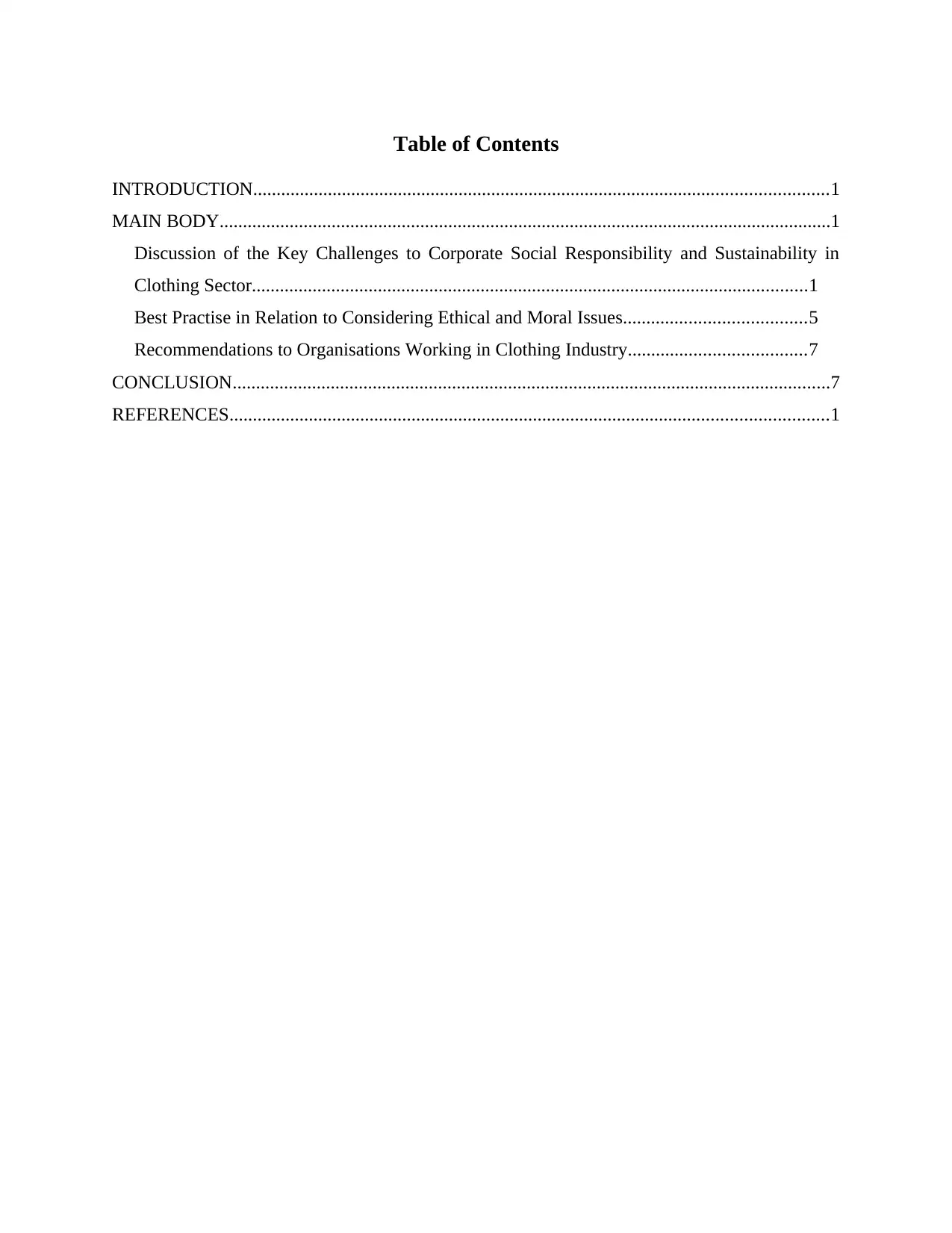
Table of Contents
INTRODUCTION...........................................................................................................................1
MAIN BODY...................................................................................................................................1
Discussion of the Key Challenges to Corporate Social Responsibility and Sustainability in
Clothing Sector.......................................................................................................................1
Best Practise in Relation to Considering Ethical and Moral Issues.......................................5
Recommendations to Organisations Working in Clothing Industry......................................7
CONCLUSION................................................................................................................................7
REFERENCES................................................................................................................................1
INTRODUCTION...........................................................................................................................1
MAIN BODY...................................................................................................................................1
Discussion of the Key Challenges to Corporate Social Responsibility and Sustainability in
Clothing Sector.......................................................................................................................1
Best Practise in Relation to Considering Ethical and Moral Issues.......................................5
Recommendations to Organisations Working in Clothing Industry......................................7
CONCLUSION................................................................................................................................7
REFERENCES................................................................................................................................1
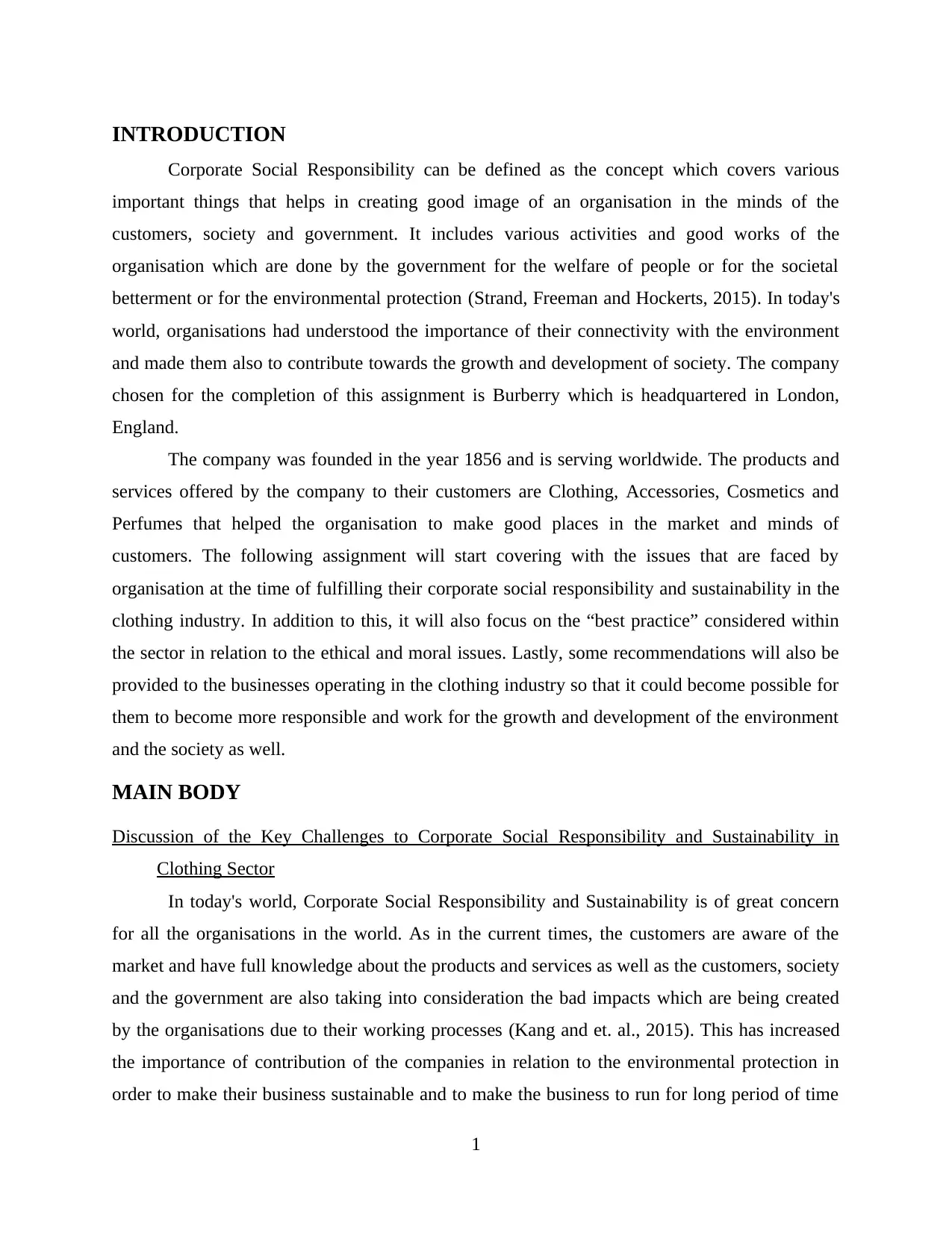
INTRODUCTION
Corporate Social Responsibility can be defined as the concept which covers various
important things that helps in creating good image of an organisation in the minds of the
customers, society and government. It includes various activities and good works of the
organisation which are done by the government for the welfare of people or for the societal
betterment or for the environmental protection (Strand, Freeman and Hockerts, 2015). In today's
world, organisations had understood the importance of their connectivity with the environment
and made them also to contribute towards the growth and development of society. The company
chosen for the completion of this assignment is Burberry which is headquartered in London,
England.
The company was founded in the year 1856 and is serving worldwide. The products and
services offered by the company to their customers are Clothing, Accessories, Cosmetics and
Perfumes that helped the organisation to make good places in the market and minds of
customers. The following assignment will start covering with the issues that are faced by
organisation at the time of fulfilling their corporate social responsibility and sustainability in the
clothing industry. In addition to this, it will also focus on the “best practice” considered within
the sector in relation to the ethical and moral issues. Lastly, some recommendations will also be
provided to the businesses operating in the clothing industry so that it could become possible for
them to become more responsible and work for the growth and development of the environment
and the society as well.
MAIN BODY
Discussion of the Key Challenges to Corporate Social Responsibility and Sustainability in
Clothing Sector
In today's world, Corporate Social Responsibility and Sustainability is of great concern
for all the organisations in the world. As in the current times, the customers are aware of the
market and have full knowledge about the products and services as well as the customers, society
and the government are also taking into consideration the bad impacts which are being created
by the organisations due to their working processes (Kang and et. al., 2015). This has increased
the importance of contribution of the companies in relation to the environmental protection in
order to make their business sustainable and to make the business to run for long period of time
1
Corporate Social Responsibility can be defined as the concept which covers various
important things that helps in creating good image of an organisation in the minds of the
customers, society and government. It includes various activities and good works of the
organisation which are done by the government for the welfare of people or for the societal
betterment or for the environmental protection (Strand, Freeman and Hockerts, 2015). In today's
world, organisations had understood the importance of their connectivity with the environment
and made them also to contribute towards the growth and development of society. The company
chosen for the completion of this assignment is Burberry which is headquartered in London,
England.
The company was founded in the year 1856 and is serving worldwide. The products and
services offered by the company to their customers are Clothing, Accessories, Cosmetics and
Perfumes that helped the organisation to make good places in the market and minds of
customers. The following assignment will start covering with the issues that are faced by
organisation at the time of fulfilling their corporate social responsibility and sustainability in the
clothing industry. In addition to this, it will also focus on the “best practice” considered within
the sector in relation to the ethical and moral issues. Lastly, some recommendations will also be
provided to the businesses operating in the clothing industry so that it could become possible for
them to become more responsible and work for the growth and development of the environment
and the society as well.
MAIN BODY
Discussion of the Key Challenges to Corporate Social Responsibility and Sustainability in
Clothing Sector
In today's world, Corporate Social Responsibility and Sustainability is of great concern
for all the organisations in the world. As in the current times, the customers are aware of the
market and have full knowledge about the products and services as well as the customers, society
and the government are also taking into consideration the bad impacts which are being created
by the organisations due to their working processes (Kang and et. al., 2015). This has increased
the importance of contribution of the companies in relation to the environmental protection in
order to make their business sustainable and to make the business to run for long period of time
1
⊘ This is a preview!⊘
Do you want full access?
Subscribe today to unlock all pages.

Trusted by 1+ million students worldwide
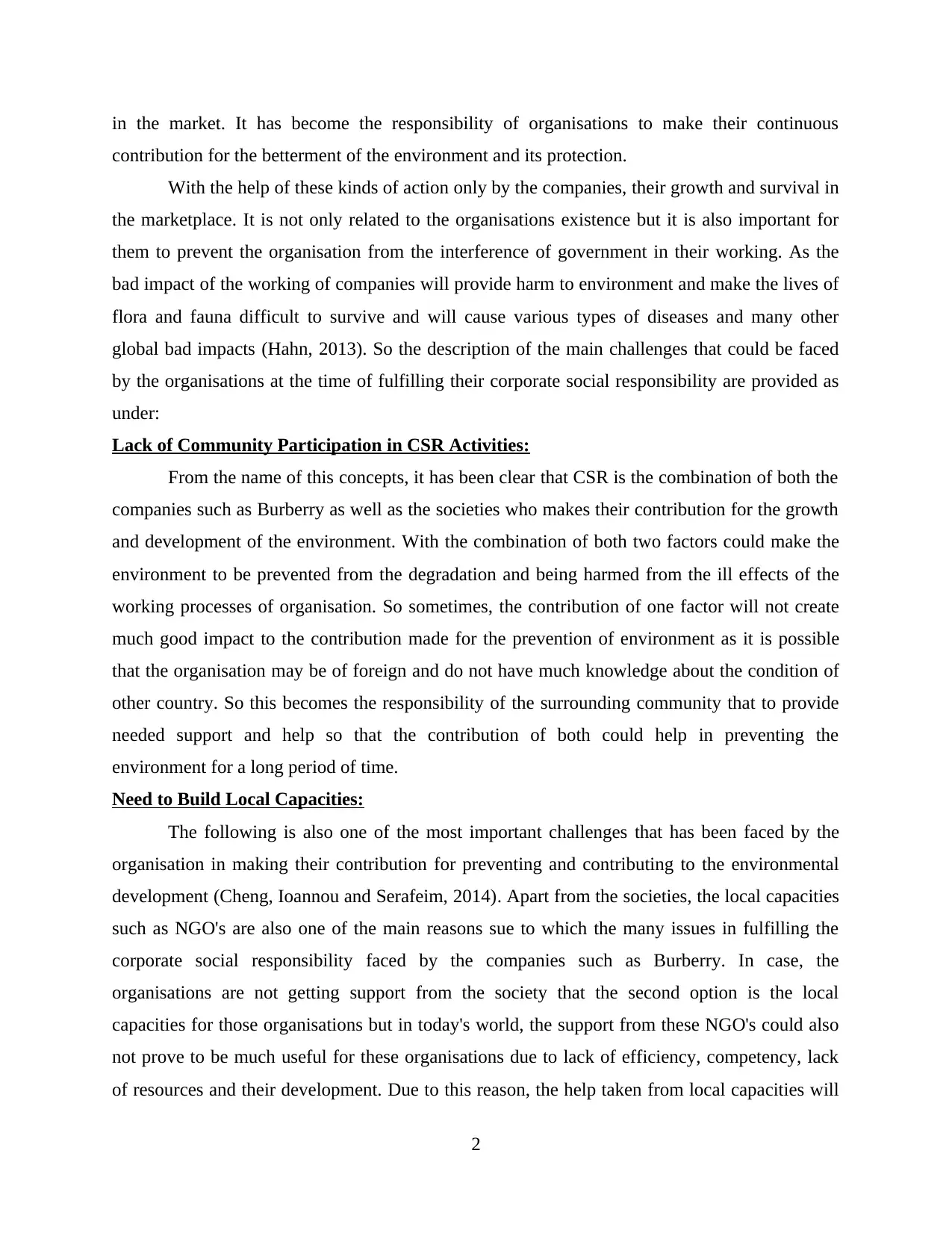
in the market. It has become the responsibility of organisations to make their continuous
contribution for the betterment of the environment and its protection.
With the help of these kinds of action only by the companies, their growth and survival in
the marketplace. It is not only related to the organisations existence but it is also important for
them to prevent the organisation from the interference of government in their working. As the
bad impact of the working of companies will provide harm to environment and make the lives of
flora and fauna difficult to survive and will cause various types of diseases and many other
global bad impacts (Hahn, 2013). So the description of the main challenges that could be faced
by the organisations at the time of fulfilling their corporate social responsibility are provided as
under:
Lack of Community Participation in CSR Activities:
From the name of this concepts, it has been clear that CSR is the combination of both the
companies such as Burberry as well as the societies who makes their contribution for the growth
and development of the environment. With the combination of both two factors could make the
environment to be prevented from the degradation and being harmed from the ill effects of the
working processes of organisation. So sometimes, the contribution of one factor will not create
much good impact to the contribution made for the prevention of environment as it is possible
that the organisation may be of foreign and do not have much knowledge about the condition of
other country. So this becomes the responsibility of the surrounding community that to provide
needed support and help so that the contribution of both could help in preventing the
environment for a long period of time.
Need to Build Local Capacities:
The following is also one of the most important challenges that has been faced by the
organisation in making their contribution for preventing and contributing to the environmental
development (Cheng, Ioannou and Serafeim, 2014). Apart from the societies, the local capacities
such as NGO's are also one of the main reasons sue to which the many issues in fulfilling the
corporate social responsibility faced by the companies such as Burberry. In case, the
organisations are not getting support from the society that the second option is the local
capacities for those organisations but in today's world, the support from these NGO's could also
not prove to be much useful for these organisations due to lack of efficiency, competency, lack
of resources and their development. Due to this reason, the help taken from local capacities will
2
contribution for the betterment of the environment and its protection.
With the help of these kinds of action only by the companies, their growth and survival in
the marketplace. It is not only related to the organisations existence but it is also important for
them to prevent the organisation from the interference of government in their working. As the
bad impact of the working of companies will provide harm to environment and make the lives of
flora and fauna difficult to survive and will cause various types of diseases and many other
global bad impacts (Hahn, 2013). So the description of the main challenges that could be faced
by the organisations at the time of fulfilling their corporate social responsibility are provided as
under:
Lack of Community Participation in CSR Activities:
From the name of this concepts, it has been clear that CSR is the combination of both the
companies such as Burberry as well as the societies who makes their contribution for the growth
and development of the environment. With the combination of both two factors could make the
environment to be prevented from the degradation and being harmed from the ill effects of the
working processes of organisation. So sometimes, the contribution of one factor will not create
much good impact to the contribution made for the prevention of environment as it is possible
that the organisation may be of foreign and do not have much knowledge about the condition of
other country. So this becomes the responsibility of the surrounding community that to provide
needed support and help so that the contribution of both could help in preventing the
environment for a long period of time.
Need to Build Local Capacities:
The following is also one of the most important challenges that has been faced by the
organisation in making their contribution for preventing and contributing to the environmental
development (Cheng, Ioannou and Serafeim, 2014). Apart from the societies, the local capacities
such as NGO's are also one of the main reasons sue to which the many issues in fulfilling the
corporate social responsibility faced by the companies such as Burberry. In case, the
organisations are not getting support from the society that the second option is the local
capacities for those organisations but in today's world, the support from these NGO's could also
not prove to be much useful for these organisations due to lack of efficiency, competency, lack
of resources and their development. Due to this reason, the help taken from local capacities will
2
Paraphrase This Document
Need a fresh take? Get an instant paraphrase of this document with our AI Paraphraser
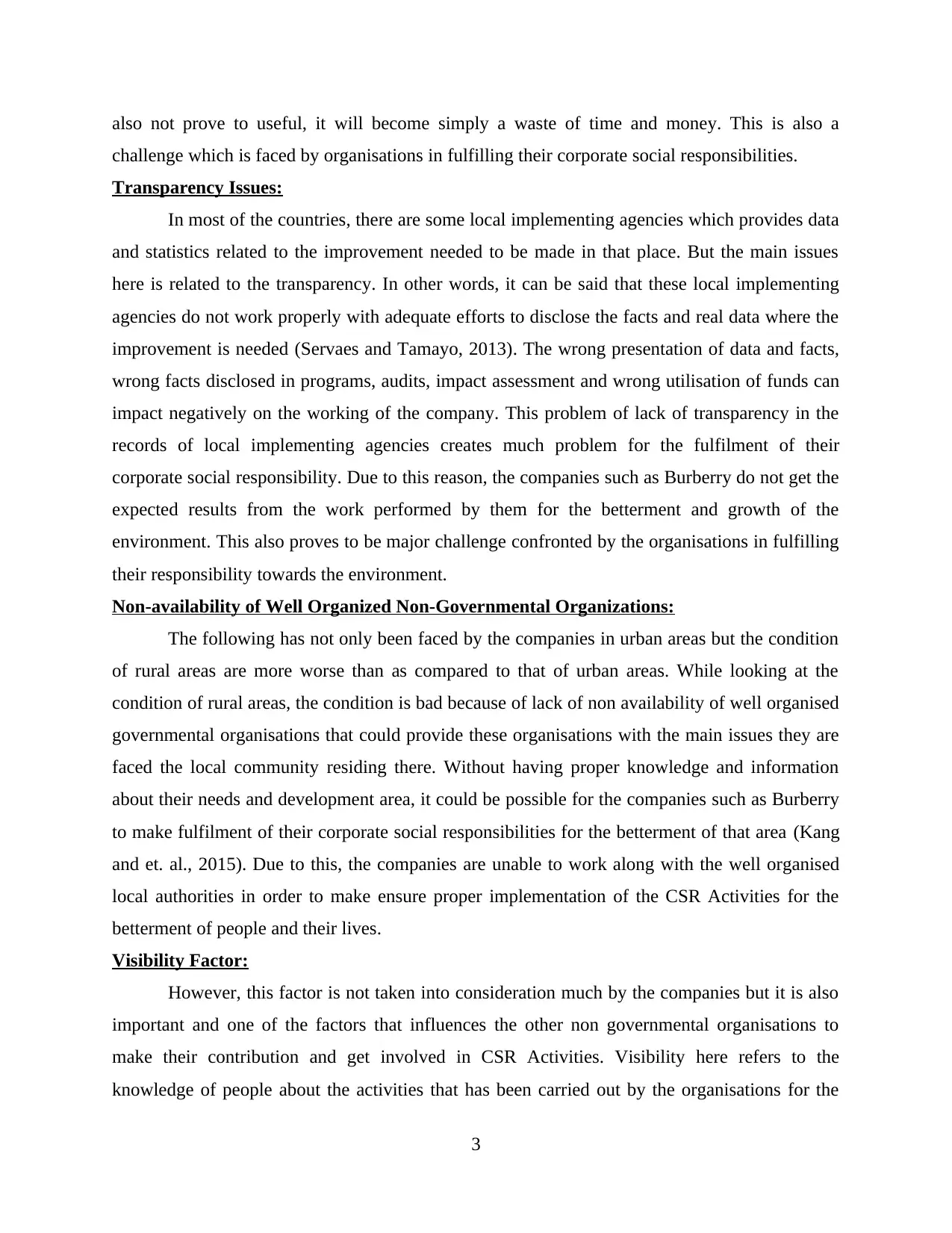
also not prove to useful, it will become simply a waste of time and money. This is also a
challenge which is faced by organisations in fulfilling their corporate social responsibilities.
Transparency Issues:
In most of the countries, there are some local implementing agencies which provides data
and statistics related to the improvement needed to be made in that place. But the main issues
here is related to the transparency. In other words, it can be said that these local implementing
agencies do not work properly with adequate efforts to disclose the facts and real data where the
improvement is needed (Servaes and Tamayo, 2013). The wrong presentation of data and facts,
wrong facts disclosed in programs, audits, impact assessment and wrong utilisation of funds can
impact negatively on the working of the company. This problem of lack of transparency in the
records of local implementing agencies creates much problem for the fulfilment of their
corporate social responsibility. Due to this reason, the companies such as Burberry do not get the
expected results from the work performed by them for the betterment and growth of the
environment. This also proves to be major challenge confronted by the organisations in fulfilling
their responsibility towards the environment.
Non-availability of Well Organized Non-Governmental Organizations:
The following has not only been faced by the companies in urban areas but the condition
of rural areas are more worse than as compared to that of urban areas. While looking at the
condition of rural areas, the condition is bad because of lack of non availability of well organised
governmental organisations that could provide these organisations with the main issues they are
faced the local community residing there. Without having proper knowledge and information
about their needs and development area, it could be possible for the companies such as Burberry
to make fulfilment of their corporate social responsibilities for the betterment of that area (Kang
and et. al., 2015). Due to this, the companies are unable to work along with the well organised
local authorities in order to make ensure proper implementation of the CSR Activities for the
betterment of people and their lives.
Visibility Factor:
However, this factor is not taken into consideration much by the companies but it is also
important and one of the factors that influences the other non governmental organisations to
make their contribution and get involved in CSR Activities. Visibility here refers to the
knowledge of people about the activities that has been carried out by the organisations for the
3
challenge which is faced by organisations in fulfilling their corporate social responsibilities.
Transparency Issues:
In most of the countries, there are some local implementing agencies which provides data
and statistics related to the improvement needed to be made in that place. But the main issues
here is related to the transparency. In other words, it can be said that these local implementing
agencies do not work properly with adequate efforts to disclose the facts and real data where the
improvement is needed (Servaes and Tamayo, 2013). The wrong presentation of data and facts,
wrong facts disclosed in programs, audits, impact assessment and wrong utilisation of funds can
impact negatively on the working of the company. This problem of lack of transparency in the
records of local implementing agencies creates much problem for the fulfilment of their
corporate social responsibility. Due to this reason, the companies such as Burberry do not get the
expected results from the work performed by them for the betterment and growth of the
environment. This also proves to be major challenge confronted by the organisations in fulfilling
their responsibility towards the environment.
Non-availability of Well Organized Non-Governmental Organizations:
The following has not only been faced by the companies in urban areas but the condition
of rural areas are more worse than as compared to that of urban areas. While looking at the
condition of rural areas, the condition is bad because of lack of non availability of well organised
governmental organisations that could provide these organisations with the main issues they are
faced the local community residing there. Without having proper knowledge and information
about their needs and development area, it could be possible for the companies such as Burberry
to make fulfilment of their corporate social responsibilities for the betterment of that area (Kang
and et. al., 2015). Due to this, the companies are unable to work along with the well organised
local authorities in order to make ensure proper implementation of the CSR Activities for the
betterment of people and their lives.
Visibility Factor:
However, this factor is not taken into consideration much by the companies but it is also
important and one of the factors that influences the other non governmental organisations to
make their contribution and get involved in CSR Activities. Visibility here refers to the
knowledge of people about the activities that has been carried out by the organisations for the
3
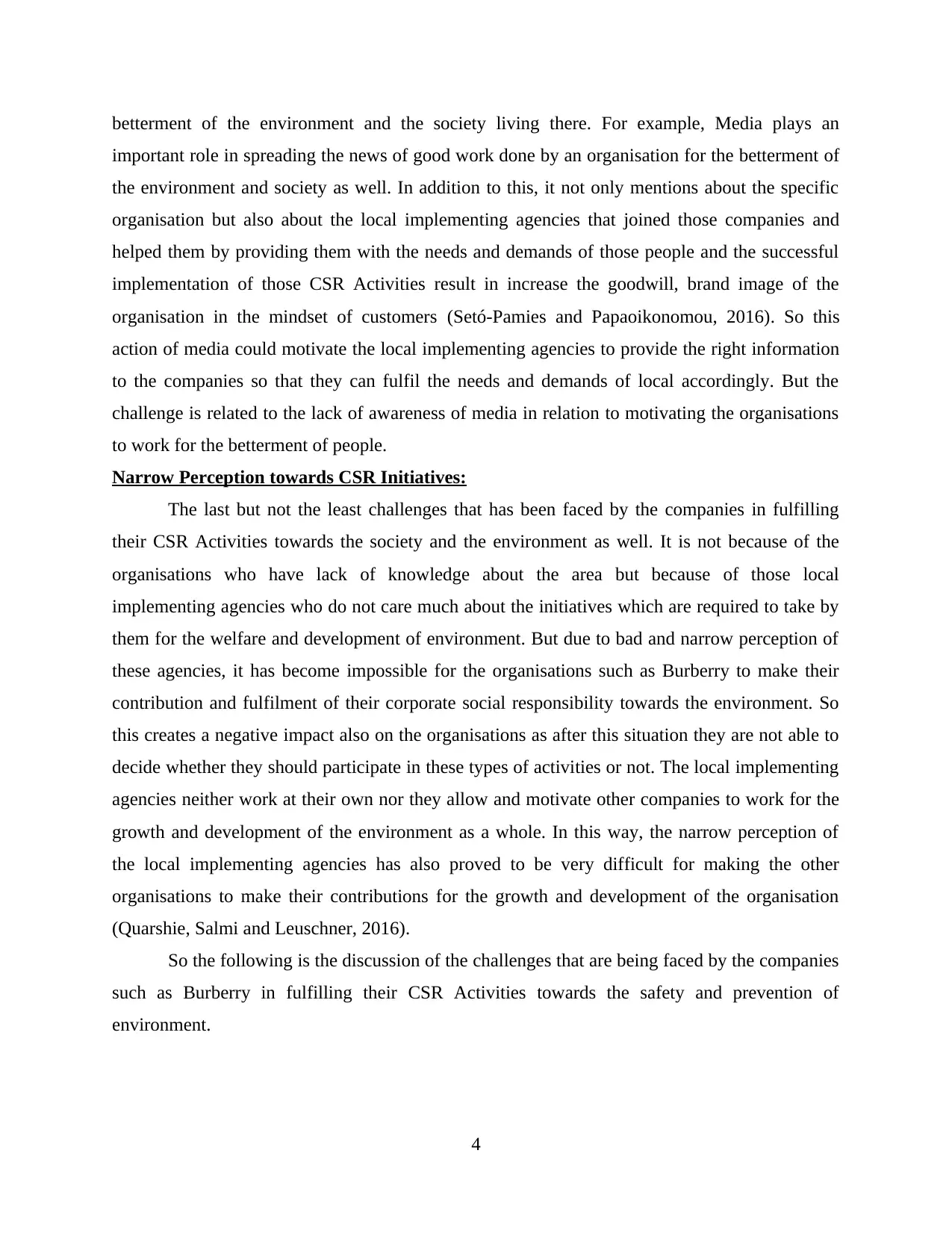
betterment of the environment and the society living there. For example, Media plays an
important role in spreading the news of good work done by an organisation for the betterment of
the environment and society as well. In addition to this, it not only mentions about the specific
organisation but also about the local implementing agencies that joined those companies and
helped them by providing them with the needs and demands of those people and the successful
implementation of those CSR Activities result in increase the goodwill, brand image of the
organisation in the mindset of customers (Setó-Pamies and Papaoikonomou, 2016). So this
action of media could motivate the local implementing agencies to provide the right information
to the companies so that they can fulfil the needs and demands of local accordingly. But the
challenge is related to the lack of awareness of media in relation to motivating the organisations
to work for the betterment of people.
Narrow Perception towards CSR Initiatives:
The last but not the least challenges that has been faced by the companies in fulfilling
their CSR Activities towards the society and the environment as well. It is not because of the
organisations who have lack of knowledge about the area but because of those local
implementing agencies who do not care much about the initiatives which are required to take by
them for the welfare and development of environment. But due to bad and narrow perception of
these agencies, it has become impossible for the organisations such as Burberry to make their
contribution and fulfilment of their corporate social responsibility towards the environment. So
this creates a negative impact also on the organisations as after this situation they are not able to
decide whether they should participate in these types of activities or not. The local implementing
agencies neither work at their own nor they allow and motivate other companies to work for the
growth and development of the environment as a whole. In this way, the narrow perception of
the local implementing agencies has also proved to be very difficult for making the other
organisations to make their contributions for the growth and development of the organisation
(Quarshie, Salmi and Leuschner, 2016).
So the following is the discussion of the challenges that are being faced by the companies
such as Burberry in fulfilling their CSR Activities towards the safety and prevention of
environment.
4
important role in spreading the news of good work done by an organisation for the betterment of
the environment and society as well. In addition to this, it not only mentions about the specific
organisation but also about the local implementing agencies that joined those companies and
helped them by providing them with the needs and demands of those people and the successful
implementation of those CSR Activities result in increase the goodwill, brand image of the
organisation in the mindset of customers (Setó-Pamies and Papaoikonomou, 2016). So this
action of media could motivate the local implementing agencies to provide the right information
to the companies so that they can fulfil the needs and demands of local accordingly. But the
challenge is related to the lack of awareness of media in relation to motivating the organisations
to work for the betterment of people.
Narrow Perception towards CSR Initiatives:
The last but not the least challenges that has been faced by the companies in fulfilling
their CSR Activities towards the society and the environment as well. It is not because of the
organisations who have lack of knowledge about the area but because of those local
implementing agencies who do not care much about the initiatives which are required to take by
them for the welfare and development of environment. But due to bad and narrow perception of
these agencies, it has become impossible for the organisations such as Burberry to make their
contribution and fulfilment of their corporate social responsibility towards the environment. So
this creates a negative impact also on the organisations as after this situation they are not able to
decide whether they should participate in these types of activities or not. The local implementing
agencies neither work at their own nor they allow and motivate other companies to work for the
growth and development of the environment as a whole. In this way, the narrow perception of
the local implementing agencies has also proved to be very difficult for making the other
organisations to make their contributions for the growth and development of the organisation
(Quarshie, Salmi and Leuschner, 2016).
So the following is the discussion of the challenges that are being faced by the companies
such as Burberry in fulfilling their CSR Activities towards the safety and prevention of
environment.
4
⊘ This is a preview!⊘
Do you want full access?
Subscribe today to unlock all pages.

Trusted by 1+ million students worldwide
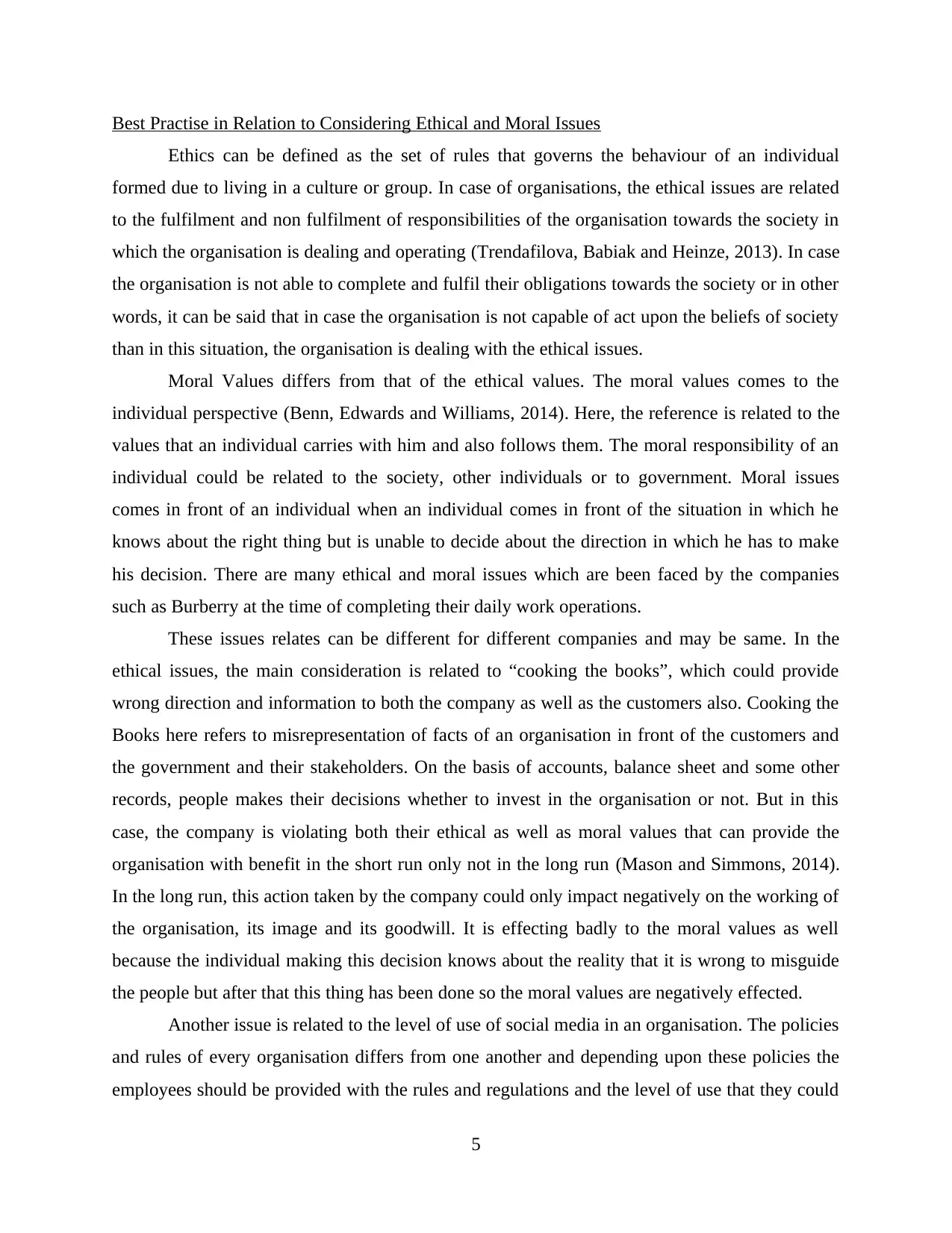
Best Practise in Relation to Considering Ethical and Moral Issues
Ethics can be defined as the set of rules that governs the behaviour of an individual
formed due to living in a culture or group. In case of organisations, the ethical issues are related
to the fulfilment and non fulfilment of responsibilities of the organisation towards the society in
which the organisation is dealing and operating (Trendafilova, Babiak and Heinze, 2013). In case
the organisation is not able to complete and fulfil their obligations towards the society or in other
words, it can be said that in case the organisation is not capable of act upon the beliefs of society
than in this situation, the organisation is dealing with the ethical issues.
Moral Values differs from that of the ethical values. The moral values comes to the
individual perspective (Benn, Edwards and Williams, 2014). Here, the reference is related to the
values that an individual carries with him and also follows them. The moral responsibility of an
individual could be related to the society, other individuals or to government. Moral issues
comes in front of an individual when an individual comes in front of the situation in which he
knows about the right thing but is unable to decide about the direction in which he has to make
his decision. There are many ethical and moral issues which are been faced by the companies
such as Burberry at the time of completing their daily work operations.
These issues relates can be different for different companies and may be same. In the
ethical issues, the main consideration is related to “cooking the books”, which could provide
wrong direction and information to both the company as well as the customers also. Cooking the
Books here refers to misrepresentation of facts of an organisation in front of the customers and
the government and their stakeholders. On the basis of accounts, balance sheet and some other
records, people makes their decisions whether to invest in the organisation or not. But in this
case, the company is violating both their ethical as well as moral values that can provide the
organisation with benefit in the short run only not in the long run (Mason and Simmons, 2014).
In the long run, this action taken by the company could only impact negatively on the working of
the organisation, its image and its goodwill. It is effecting badly to the moral values as well
because the individual making this decision knows about the reality that it is wrong to misguide
the people but after that this thing has been done so the moral values are negatively effected.
Another issue is related to the level of use of social media in an organisation. The policies
and rules of every organisation differs from one another and depending upon these policies the
employees should be provided with the rules and regulations and the level of use that they could
5
Ethics can be defined as the set of rules that governs the behaviour of an individual
formed due to living in a culture or group. In case of organisations, the ethical issues are related
to the fulfilment and non fulfilment of responsibilities of the organisation towards the society in
which the organisation is dealing and operating (Trendafilova, Babiak and Heinze, 2013). In case
the organisation is not able to complete and fulfil their obligations towards the society or in other
words, it can be said that in case the organisation is not capable of act upon the beliefs of society
than in this situation, the organisation is dealing with the ethical issues.
Moral Values differs from that of the ethical values. The moral values comes to the
individual perspective (Benn, Edwards and Williams, 2014). Here, the reference is related to the
values that an individual carries with him and also follows them. The moral responsibility of an
individual could be related to the society, other individuals or to government. Moral issues
comes in front of an individual when an individual comes in front of the situation in which he
knows about the right thing but is unable to decide about the direction in which he has to make
his decision. There are many ethical and moral issues which are been faced by the companies
such as Burberry at the time of completing their daily work operations.
These issues relates can be different for different companies and may be same. In the
ethical issues, the main consideration is related to “cooking the books”, which could provide
wrong direction and information to both the company as well as the customers also. Cooking the
Books here refers to misrepresentation of facts of an organisation in front of the customers and
the government and their stakeholders. On the basis of accounts, balance sheet and some other
records, people makes their decisions whether to invest in the organisation or not. But in this
case, the company is violating both their ethical as well as moral values that can provide the
organisation with benefit in the short run only not in the long run (Mason and Simmons, 2014).
In the long run, this action taken by the company could only impact negatively on the working of
the organisation, its image and its goodwill. It is effecting badly to the moral values as well
because the individual making this decision knows about the reality that it is wrong to misguide
the people but after that this thing has been done so the moral values are negatively effected.
Another issue is related to the level of use of social media in an organisation. The policies
and rules of every organisation differs from one another and depending upon these policies the
employees should be provided with the rules and regulations and the level of use that they could
5
Paraphrase This Document
Need a fresh take? Get an instant paraphrase of this document with our AI Paraphraser
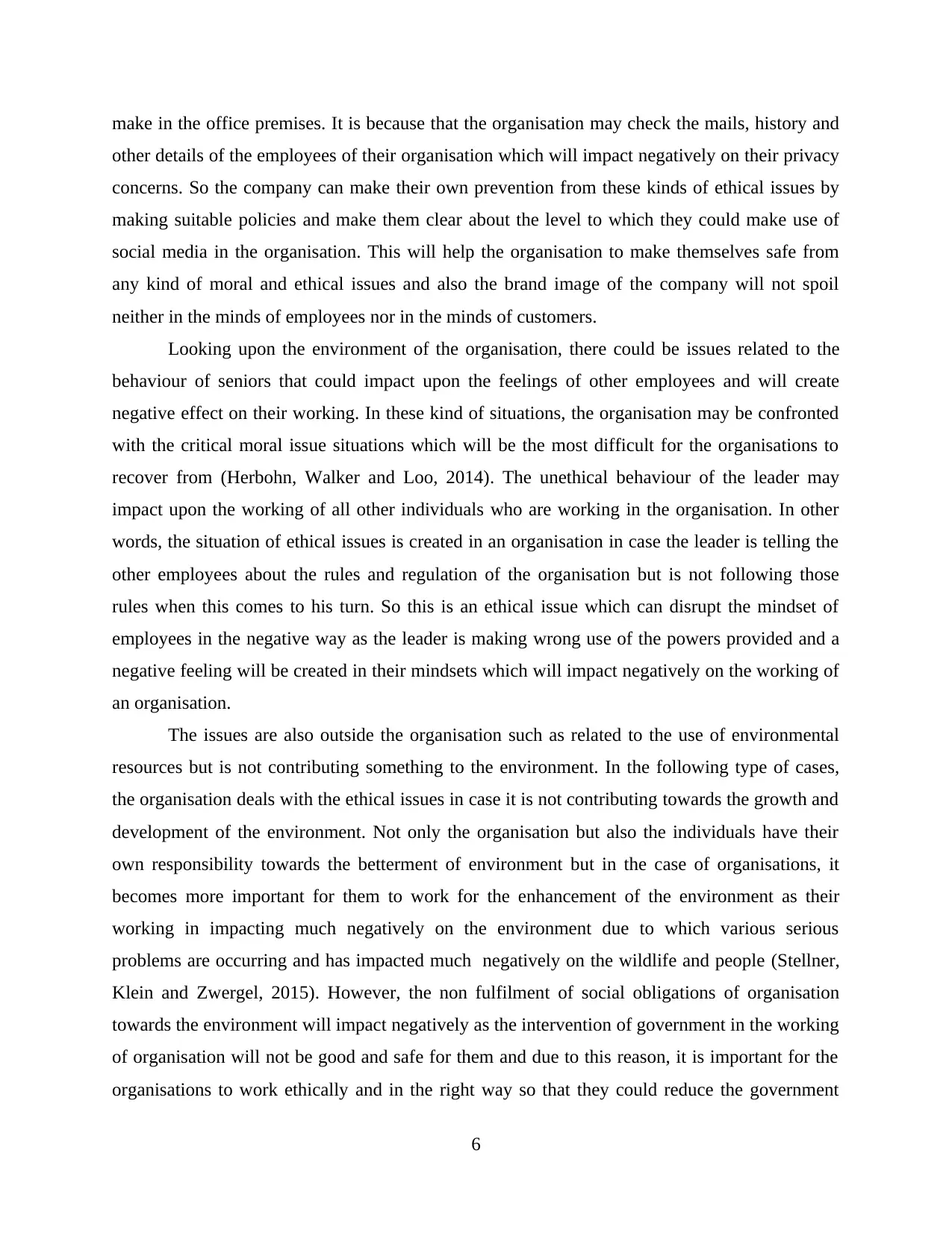
make in the office premises. It is because that the organisation may check the mails, history and
other details of the employees of their organisation which will impact negatively on their privacy
concerns. So the company can make their own prevention from these kinds of ethical issues by
making suitable policies and make them clear about the level to which they could make use of
social media in the organisation. This will help the organisation to make themselves safe from
any kind of moral and ethical issues and also the brand image of the company will not spoil
neither in the minds of employees nor in the minds of customers.
Looking upon the environment of the organisation, there could be issues related to the
behaviour of seniors that could impact upon the feelings of other employees and will create
negative effect on their working. In these kind of situations, the organisation may be confronted
with the critical moral issue situations which will be the most difficult for the organisations to
recover from (Herbohn, Walker and Loo, 2014). The unethical behaviour of the leader may
impact upon the working of all other individuals who are working in the organisation. In other
words, the situation of ethical issues is created in an organisation in case the leader is telling the
other employees about the rules and regulation of the organisation but is not following those
rules when this comes to his turn. So this is an ethical issue which can disrupt the mindset of
employees in the negative way as the leader is making wrong use of the powers provided and a
negative feeling will be created in their mindsets which will impact negatively on the working of
an organisation.
The issues are also outside the organisation such as related to the use of environmental
resources but is not contributing something to the environment. In the following type of cases,
the organisation deals with the ethical issues in case it is not contributing towards the growth and
development of the environment. Not only the organisation but also the individuals have their
own responsibility towards the betterment of environment but in the case of organisations, it
becomes more important for them to work for the enhancement of the environment as their
working in impacting much negatively on the environment due to which various serious
problems are occurring and has impacted much negatively on the wildlife and people (Stellner,
Klein and Zwergel, 2015). However, the non fulfilment of social obligations of organisation
towards the environment will impact negatively as the intervention of government in the working
of organisation will not be good and safe for them and due to this reason, it is important for the
organisations to work ethically and in the right way so that they could reduce the government
6
other details of the employees of their organisation which will impact negatively on their privacy
concerns. So the company can make their own prevention from these kinds of ethical issues by
making suitable policies and make them clear about the level to which they could make use of
social media in the organisation. This will help the organisation to make themselves safe from
any kind of moral and ethical issues and also the brand image of the company will not spoil
neither in the minds of employees nor in the minds of customers.
Looking upon the environment of the organisation, there could be issues related to the
behaviour of seniors that could impact upon the feelings of other employees and will create
negative effect on their working. In these kind of situations, the organisation may be confronted
with the critical moral issue situations which will be the most difficult for the organisations to
recover from (Herbohn, Walker and Loo, 2014). The unethical behaviour of the leader may
impact upon the working of all other individuals who are working in the organisation. In other
words, the situation of ethical issues is created in an organisation in case the leader is telling the
other employees about the rules and regulation of the organisation but is not following those
rules when this comes to his turn. So this is an ethical issue which can disrupt the mindset of
employees in the negative way as the leader is making wrong use of the powers provided and a
negative feeling will be created in their mindsets which will impact negatively on the working of
an organisation.
The issues are also outside the organisation such as related to the use of environmental
resources but is not contributing something to the environment. In the following type of cases,
the organisation deals with the ethical issues in case it is not contributing towards the growth and
development of the environment. Not only the organisation but also the individuals have their
own responsibility towards the betterment of environment but in the case of organisations, it
becomes more important for them to work for the enhancement of the environment as their
working in impacting much negatively on the environment due to which various serious
problems are occurring and has impacted much negatively on the wildlife and people (Stellner,
Klein and Zwergel, 2015). However, the non fulfilment of social obligations of organisation
towards the environment will impact negatively as the intervention of government in the working
of organisation will not be good and safe for them and due to this reason, it is important for the
organisations to work ethically and in the right way so that they could reduce the government
6
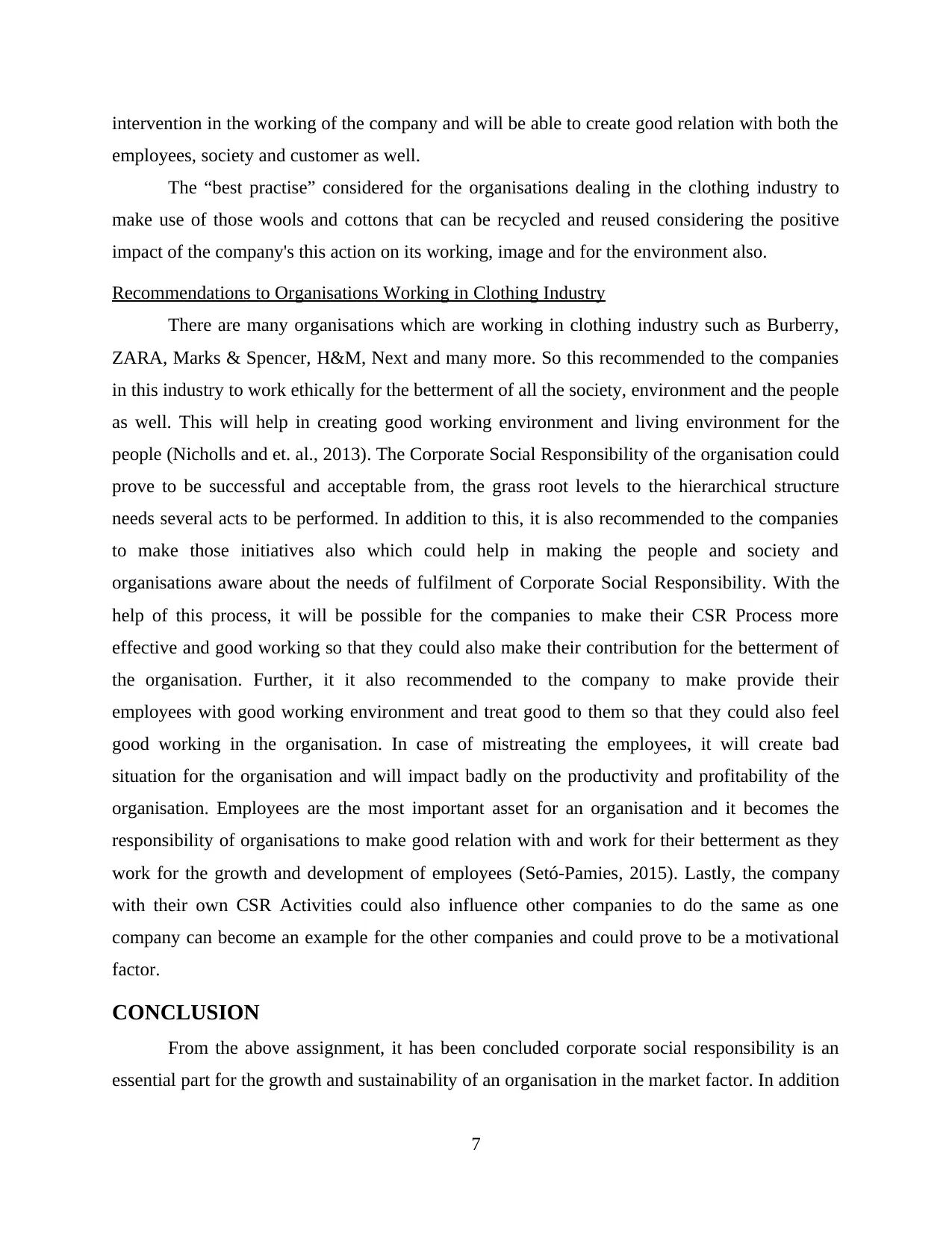
intervention in the working of the company and will be able to create good relation with both the
employees, society and customer as well.
The “best practise” considered for the organisations dealing in the clothing industry to
make use of those wools and cottons that can be recycled and reused considering the positive
impact of the company's this action on its working, image and for the environment also.
Recommendations to Organisations Working in Clothing Industry
There are many organisations which are working in clothing industry such as Burberry,
ZARA, Marks & Spencer, H&M, Next and many more. So this recommended to the companies
in this industry to work ethically for the betterment of all the society, environment and the people
as well. This will help in creating good working environment and living environment for the
people (Nicholls and et. al., 2013). The Corporate Social Responsibility of the organisation could
prove to be successful and acceptable from, the grass root levels to the hierarchical structure
needs several acts to be performed. In addition to this, it is also recommended to the companies
to make those initiatives also which could help in making the people and society and
organisations aware about the needs of fulfilment of Corporate Social Responsibility. With the
help of this process, it will be possible for the companies to make their CSR Process more
effective and good working so that they could also make their contribution for the betterment of
the organisation. Further, it it also recommended to the company to make provide their
employees with good working environment and treat good to them so that they could also feel
good working in the organisation. In case of mistreating the employees, it will create bad
situation for the organisation and will impact badly on the productivity and profitability of the
organisation. Employees are the most important asset for an organisation and it becomes the
responsibility of organisations to make good relation with and work for their betterment as they
work for the growth and development of employees (Setó‐Pamies, 2015). Lastly, the company
with their own CSR Activities could also influence other companies to do the same as one
company can become an example for the other companies and could prove to be a motivational
factor.
CONCLUSION
From the above assignment, it has been concluded corporate social responsibility is an
essential part for the growth and sustainability of an organisation in the market factor. In addition
7
employees, society and customer as well.
The “best practise” considered for the organisations dealing in the clothing industry to
make use of those wools and cottons that can be recycled and reused considering the positive
impact of the company's this action on its working, image and for the environment also.
Recommendations to Organisations Working in Clothing Industry
There are many organisations which are working in clothing industry such as Burberry,
ZARA, Marks & Spencer, H&M, Next and many more. So this recommended to the companies
in this industry to work ethically for the betterment of all the society, environment and the people
as well. This will help in creating good working environment and living environment for the
people (Nicholls and et. al., 2013). The Corporate Social Responsibility of the organisation could
prove to be successful and acceptable from, the grass root levels to the hierarchical structure
needs several acts to be performed. In addition to this, it is also recommended to the companies
to make those initiatives also which could help in making the people and society and
organisations aware about the needs of fulfilment of Corporate Social Responsibility. With the
help of this process, it will be possible for the companies to make their CSR Process more
effective and good working so that they could also make their contribution for the betterment of
the organisation. Further, it it also recommended to the company to make provide their
employees with good working environment and treat good to them so that they could also feel
good working in the organisation. In case of mistreating the employees, it will create bad
situation for the organisation and will impact badly on the productivity and profitability of the
organisation. Employees are the most important asset for an organisation and it becomes the
responsibility of organisations to make good relation with and work for their betterment as they
work for the growth and development of employees (Setó‐Pamies, 2015). Lastly, the company
with their own CSR Activities could also influence other companies to do the same as one
company can become an example for the other companies and could prove to be a motivational
factor.
CONCLUSION
From the above assignment, it has been concluded corporate social responsibility is an
essential part for the growth and sustainability of an organisation in the market factor. In addition
7
⊘ This is a preview!⊘
Do you want full access?
Subscribe today to unlock all pages.

Trusted by 1+ million students worldwide
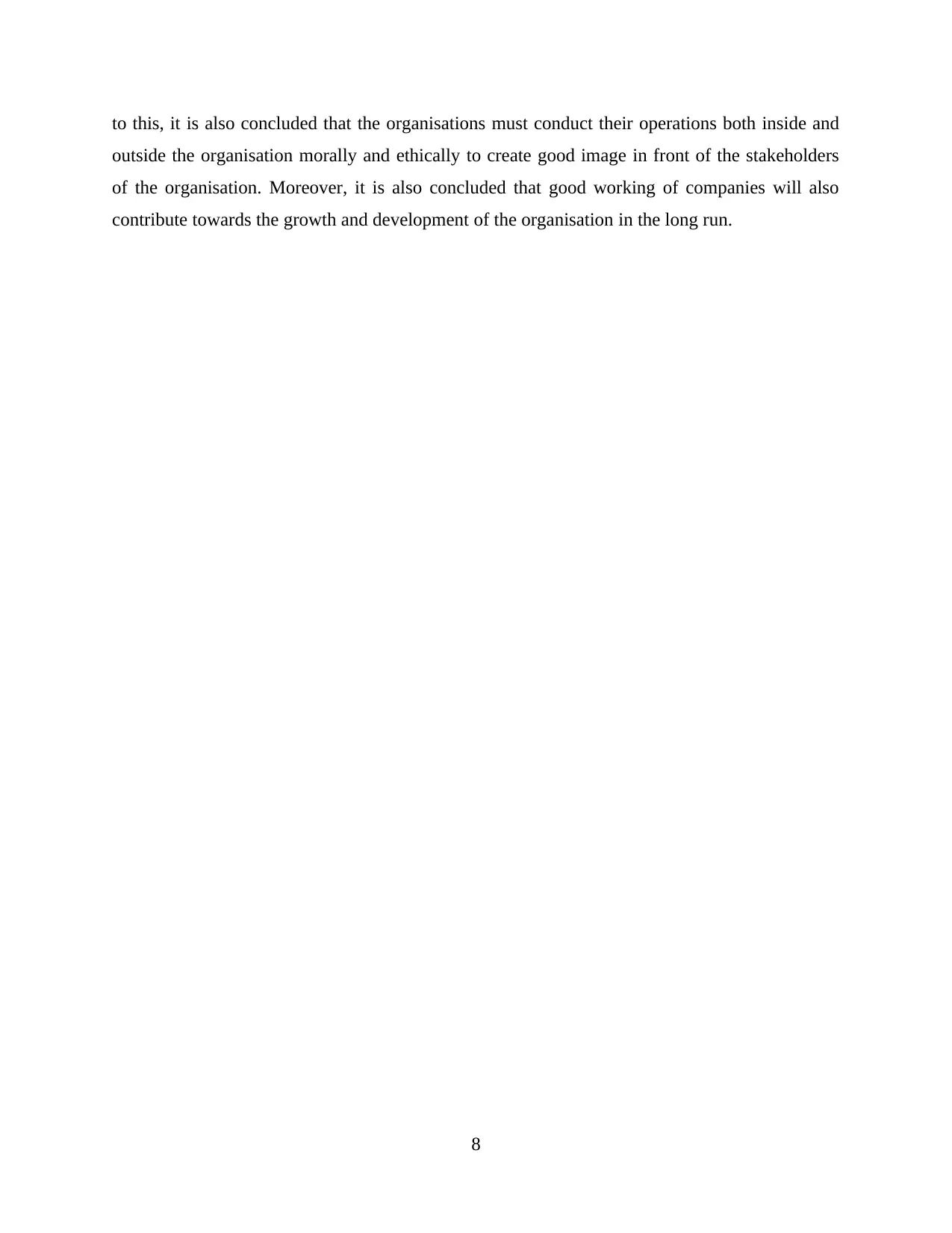
to this, it is also concluded that the organisations must conduct their operations both inside and
outside the organisation morally and ethically to create good image in front of the stakeholders
of the organisation. Moreover, it is also concluded that good working of companies will also
contribute towards the growth and development of the organisation in the long run.
8
outside the organisation morally and ethically to create good image in front of the stakeholders
of the organisation. Moreover, it is also concluded that good working of companies will also
contribute towards the growth and development of the organisation in the long run.
8
Paraphrase This Document
Need a fresh take? Get an instant paraphrase of this document with our AI Paraphraser
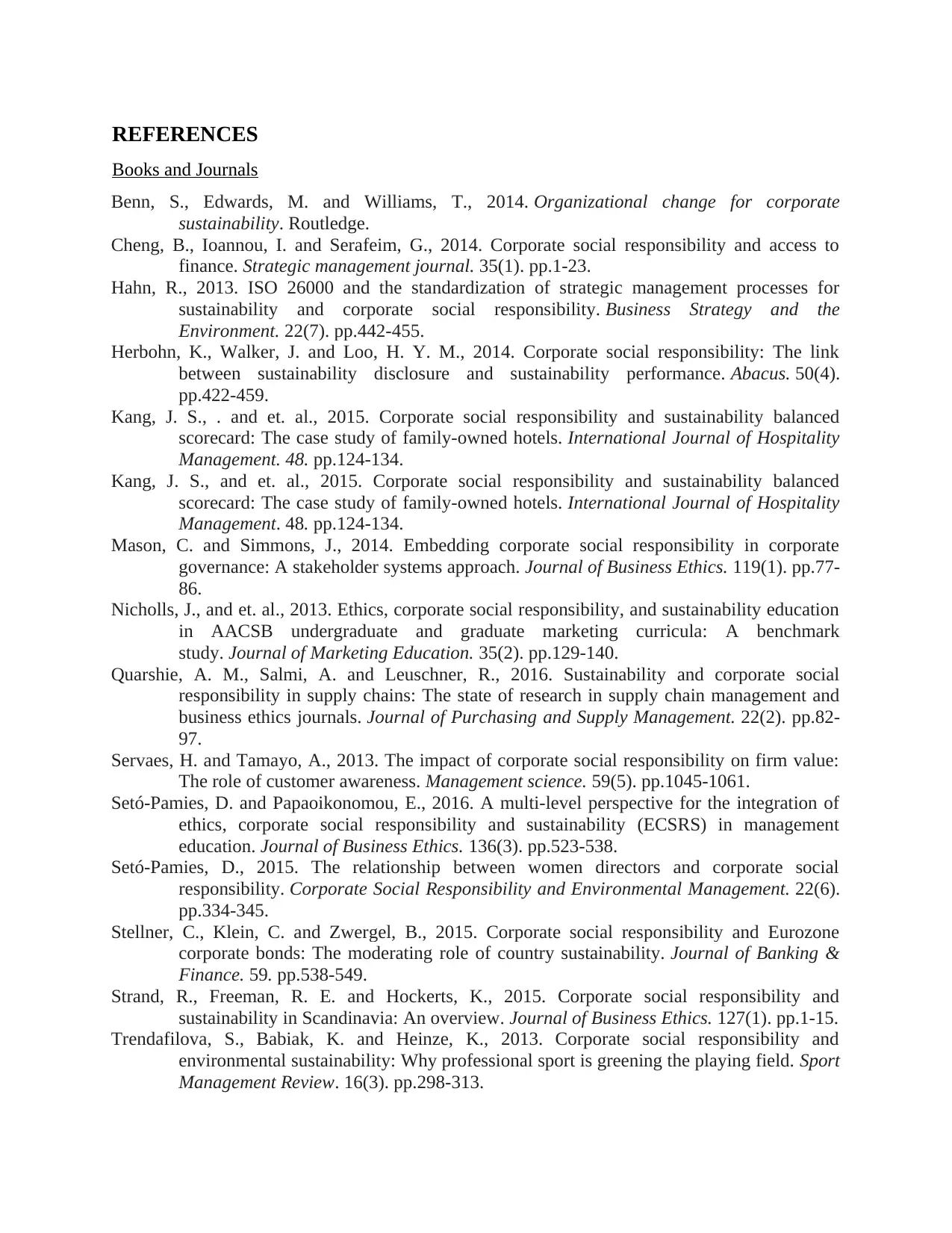
REFERENCES
Books and Journals
Benn, S., Edwards, M. and Williams, T., 2014. Organizational change for corporate
sustainability. Routledge.
Cheng, B., Ioannou, I. and Serafeim, G., 2014. Corporate social responsibility and access to
finance. Strategic management journal. 35(1). pp.1-23.
Hahn, R., 2013. ISO 26000 and the standardization of strategic management processes for
sustainability and corporate social responsibility. Business Strategy and the
Environment. 22(7). pp.442-455.
Herbohn, K., Walker, J. and Loo, H. Y. M., 2014. Corporate social responsibility: The link
between sustainability disclosure and sustainability performance. Abacus. 50(4).
pp.422-459.
Kang, J. S., . and et. al., 2015. Corporate social responsibility and sustainability balanced
scorecard: The case study of family-owned hotels. International Journal of Hospitality
Management. 48. pp.124-134.
Kang, J. S., and et. al., 2015. Corporate social responsibility and sustainability balanced
scorecard: The case study of family-owned hotels. International Journal of Hospitality
Management. 48. pp.124-134.
Mason, C. and Simmons, J., 2014. Embedding corporate social responsibility in corporate
governance: A stakeholder systems approach. Journal of Business Ethics. 119(1). pp.77-
86.
Nicholls, J., and et. al., 2013. Ethics, corporate social responsibility, and sustainability education
in AACSB undergraduate and graduate marketing curricula: A benchmark
study. Journal of Marketing Education. 35(2). pp.129-140.
Quarshie, A. M., Salmi, A. and Leuschner, R., 2016. Sustainability and corporate social
responsibility in supply chains: The state of research in supply chain management and
business ethics journals. Journal of Purchasing and Supply Management. 22(2). pp.82-
97.
Servaes, H. and Tamayo, A., 2013. The impact of corporate social responsibility on firm value:
The role of customer awareness. Management science. 59(5). pp.1045-1061.
Setó-Pamies, D. and Papaoikonomou, E., 2016. A multi-level perspective for the integration of
ethics, corporate social responsibility and sustainability (ECSRS) in management
education. Journal of Business Ethics. 136(3). pp.523-538.
Setó‐Pamies, D., 2015. The relationship between women directors and corporate social
responsibility. Corporate Social Responsibility and Environmental Management. 22(6).
pp.334-345.
Stellner, C., Klein, C. and Zwergel, B., 2015. Corporate social responsibility and Eurozone
corporate bonds: The moderating role of country sustainability. Journal of Banking &
Finance. 59. pp.538-549.
Strand, R., Freeman, R. E. and Hockerts, K., 2015. Corporate social responsibility and
sustainability in Scandinavia: An overview. Journal of Business Ethics. 127(1). pp.1-15.
Trendafilova, S., Babiak, K. and Heinze, K., 2013. Corporate social responsibility and
environmental sustainability: Why professional sport is greening the playing field. Sport
Management Review. 16(3). pp.298-313.
Books and Journals
Benn, S., Edwards, M. and Williams, T., 2014. Organizational change for corporate
sustainability. Routledge.
Cheng, B., Ioannou, I. and Serafeim, G., 2014. Corporate social responsibility and access to
finance. Strategic management journal. 35(1). pp.1-23.
Hahn, R., 2013. ISO 26000 and the standardization of strategic management processes for
sustainability and corporate social responsibility. Business Strategy and the
Environment. 22(7). pp.442-455.
Herbohn, K., Walker, J. and Loo, H. Y. M., 2014. Corporate social responsibility: The link
between sustainability disclosure and sustainability performance. Abacus. 50(4).
pp.422-459.
Kang, J. S., . and et. al., 2015. Corporate social responsibility and sustainability balanced
scorecard: The case study of family-owned hotels. International Journal of Hospitality
Management. 48. pp.124-134.
Kang, J. S., and et. al., 2015. Corporate social responsibility and sustainability balanced
scorecard: The case study of family-owned hotels. International Journal of Hospitality
Management. 48. pp.124-134.
Mason, C. and Simmons, J., 2014. Embedding corporate social responsibility in corporate
governance: A stakeholder systems approach. Journal of Business Ethics. 119(1). pp.77-
86.
Nicholls, J., and et. al., 2013. Ethics, corporate social responsibility, and sustainability education
in AACSB undergraduate and graduate marketing curricula: A benchmark
study. Journal of Marketing Education. 35(2). pp.129-140.
Quarshie, A. M., Salmi, A. and Leuschner, R., 2016. Sustainability and corporate social
responsibility in supply chains: The state of research in supply chain management and
business ethics journals. Journal of Purchasing and Supply Management. 22(2). pp.82-
97.
Servaes, H. and Tamayo, A., 2013. The impact of corporate social responsibility on firm value:
The role of customer awareness. Management science. 59(5). pp.1045-1061.
Setó-Pamies, D. and Papaoikonomou, E., 2016. A multi-level perspective for the integration of
ethics, corporate social responsibility and sustainability (ECSRS) in management
education. Journal of Business Ethics. 136(3). pp.523-538.
Setó‐Pamies, D., 2015. The relationship between women directors and corporate social
responsibility. Corporate Social Responsibility and Environmental Management. 22(6).
pp.334-345.
Stellner, C., Klein, C. and Zwergel, B., 2015. Corporate social responsibility and Eurozone
corporate bonds: The moderating role of country sustainability. Journal of Banking &
Finance. 59. pp.538-549.
Strand, R., Freeman, R. E. and Hockerts, K., 2015. Corporate social responsibility and
sustainability in Scandinavia: An overview. Journal of Business Ethics. 127(1). pp.1-15.
Trendafilova, S., Babiak, K. and Heinze, K., 2013. Corporate social responsibility and
environmental sustainability: Why professional sport is greening the playing field. Sport
Management Review. 16(3). pp.298-313.
1 out of 11
Related Documents
Your All-in-One AI-Powered Toolkit for Academic Success.
+13062052269
info@desklib.com
Available 24*7 on WhatsApp / Email
![[object Object]](/_next/static/media/star-bottom.7253800d.svg)
Unlock your academic potential
Copyright © 2020–2025 A2Z Services. All Rights Reserved. Developed and managed by ZUCOL.




